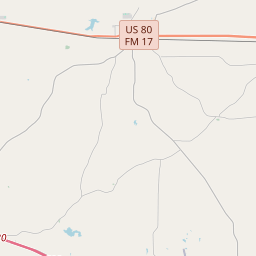Railroads in Mineola
Historical marker location:






This city's fortunes have been tied historically to railroads. Mineola was born in the summer of 1873, as the Houston and Great Northern (later International and Great Northern) and Texas and Pacific lines raced to a predetermined crossing point. The company arriving first would secure ownership of rail facilities, so construction crews worked day and night, with the I&GN building northwest from near Tyler and the T&P extending westward from Longview. The two lines neared this spot on the same day and the crews were within sight of each other that morning. Accounts differ on which railroad won the competition, with disagreement over the exact surveyed location and whether being first meant the first tracks or first train to arrive.
The City of Mineola incorporated in 1877 and its rail success continued as the Missouri, Kansas and Texas line extended to Greenville in 1881. This connected the growing trade center with major cities -- Dallas, Sherman, Shreveport and Houston -- in all directions. The railroads also brought new settlers to Mineola, and a new depot opened in 1905. The T&P moved its terminal here from Longview in 1929, bringing about 200 employees and making a significant economic impact on the city. Its presence sustained Mineola while other towns suffered through the Great Depression. In the following years, a new fire department, post office and schools were in operation. The city became a shipping center for agriculture, notably watermelons, sweet potatoes and cotton.
The T&P dedicated a new passenger depot in 1951, but rail connections to Greenville and Lindale were later abandoned. Passenger service, suspended in Mineola's centennial year of 1973, returned in 1996. (2007)
As one of the most visible programs of the Texas Historical Commission (THC), historical markers commemorate diverse topics in Texas history, including: the history and architecture of houses, commercial and public buildings, religious congregations, and military sites; events that changed the course of local and state history; and individuals who have made lasting contributions to the state, community organizations, and businesses.
The state of Texas was once an independent country known as the Republic of Texas. It gained independence from Mexico in 1836 and was a separate nation until it was annexed by the United States in 1845.
In the early 1800s, the region attracted settlers from the United States who were drawn to the lush forests and abundant resources. The first permanent European-American settlement was established in 1846, and it was named Quitman after John A. Quitman, a prominent politician of that time.
During the Civil War, Wood County played a significant role in supporting the Confederacy. Many residents enlisted in the Confederate Army, and the area became a center for military recruitment and training. After the war, the county suffered economically, but with the introduction of the railroad in the late 19th century, the economy began to recover.
Wood County's economy primarily relied on agriculture, with the growth of cotton, corn, and timber industries. The establishment of sawmills and the development of the timber industry brought prosperity to the area. In the early 20th century, the discovery of oil and gas reserves further fueled the county's economic development.
Today, Wood County continues to be an important agricultural and industrial center in Texas. The county's history is evident in its charming small towns, historic sites, and natural beauty. The strong sense of community and appreciation for the region's heritage are still evident today, making Wood County a vibrant and inviting place to visit or live.
Wood County Timeline
This timeline provides a glimpse into the major events and milestones that have shaped the history of Wood County, Texas.
- 1850: Wood County is established by the Texas legislature.
- 1852: The first courthouse in Wood County is built in Quitman.
- 1860: The population of Wood County reaches 4,867.
- 1875: The railroad reaches Wood County, boosting economic growth.
- 1895: The county seat is moved from Quitman to Mineola.
- 1920: The population of Wood County peaks at 19,109.
- 1930: The Great Depression hits Wood County, causing economic hardship.
- 1958: Lake Holbrook is completed, providing a recreational area for residents.
- 1970: Wood County's population decreases to 12,230.
- 1983: Holly Lake Ranch, a gated residential community, is established in Wood County.
- 2000: The population of Wood County surpasses 37,000.
- 2019: Wood County experiences steady growth and continues to be a thriving community.